Analysis and Control of Rumor Propagation Model Considering Multiple Waiting Phases
Abstract
1. Introduction
- (1)
- Establish the initial model by introducing class C members (commenters), representing individuals who engage in commenting on the rumor event, and class W members (waiters), representing neutral waiting individuals who, after being exposed to the event, choose to observe the development of the situation.
- (2)
- Consider the nature of secondary infection, where neutral wait-and-see individuals may include those who temporarily awakened but later returned to believing the rumor. At the same time, the model also considers the varying rumor propagation abilities corresponding to different levels of belief in the rumor.
- (3)
- Introduce government intervention to guide the population in resisting rumors; incorporate information popularization rate and information timeliness to study their impacts on rumor propagation. Propose a debunking coefficient and an information timeliness coefficient to improve the SCWIR model.
- (4)
- Accelerate the decay of information value, strengthen government debunking efforts, and implement earlier interventions to ensure the basic reproduction number , thereby suppressing rumors.
2. Preparation Work
2.1. SEIR Rumor Propagation Model
2.2. Comparative Analysis
- (1)
- It accounts for the various possibilities of user stance transitions during rumor events. These transitions are reversible and multidirectional, comprehensively considering users shifting between commenting, believing, remaining neutral, or being indifferent upon encountering rumors. It also considers the situation where users wait multiple times for the development of the situation.
- (2)
- It examines the effect of factors such as information popularization rate and information timeliness on different user groups during rumor propagation. Additionally, it explores the role of government intervention in guiding user behavior.
- (3)
- It considers the different roles that neutral waiting, commenting, and forwarding groups of believers play in rumor propagation.
3. SCWIR Rumor Propagation Model
3.1. Model Description
- (1)
- Assume the total population is N, where the initial spreaders (I) account for one-thousandth of the population, and the remaining individuals are susceptible (S). During the propagation process, no new nodes are added or removed, and the total population N remains constant.
- (2)
- Wait-and-see individuals (W) include those who adopt a neutral, wait-and-see stance after first encountering the rumor, as well as those who, after initially believing the rumor, awaken and revert to waiting again. This means that wait-and-see individuals have the potential to believe the rumor a second time.
- (3)
- Commenters (C) and spreaders (I) occasionally spread rumors, causing the susceptible individuals they interact with to transition into commenters (C), wait-and-see individuals (W), spreaders (I), or immune individuals (R) with probabilities , , , and , respectively. Similarly, wait-and-see individuals (W) interacting with commenters (C) or spreaders (I) transition to commenters (C), immune individuals (R), or spreaders (I) with probabilities , , and , respectively.
- (4)
- Commenters (C) have a weaker spreading ability compared to spreaders (I), with the model assuming C’s ability is half that of I.
- (5)
- Commenters (C) who come into contact with spreaders (I) may transition into new spreaders with a probability . Additionally, commenters may awaken and adopt a wait-and-see stance with a probability of or become immune to the rumor with a probability of .
- (6)
- Spreaders (I) have the potential to awaken, transitioning to wait-and-see individuals (W) with a probability or to immune individuals (R) with a probability .
- (7)
3.2. Propagation Dynamics Equation
3.3. Quantitative Analysis of Influencing Factors
3.3.1. Information Timeliness
3.3.2. Government Intervention
3.3.3. Information Popularization Rate
3.4. The Improved SCWIR Model
4. Stability Analysis
4.1. Stability Analysis of the Rumor-Free Equilibrium Point
4.1.1. Local Stability Analysis of the Rumor-Free Equilibrium Point
4.1.2. Global Stability Analysis of the Rumor-Free Equilibrium Point
4.2. Stability Analysis of the Rumor Equilibrium Point
4.2.1. Local Stability Analysis of the Rumor Equilibrium Point
4.2.2. Global Stability Analysis of the Rumor Equilibrium Point
5. Experiment and Result Analysis
5.1. Related Networks
5.2. Experimental Design
- (1)
- The data for nodes and edges in each network are shown in Table 2.
- (2)
- Each network undergoes 1000 independent experiments, and the final results are taken as the average of the experimental outcomes.
- (3)
- N represents the total number of network nodes, and the initial number of information sources is set as of the total nodes, rounded up if not divisible.
- (4)
- Model parameter settings. The infection and recovery probabilities in the SIS model are 0.7 and 0.3, respectively. The infection and recovery probabilities in the SIR model are 0.7 and 0.3, respectively. The latency, infection, and recovery probabilities in the SEIR model are 0.3, 0.7, and 0.3, respectively. The experimental parameters for the SCWIR model are as follows: .
- (5)
- All experiments in this paper were conducted using the MATLAB programming tool, version MATLAB R2018a.
5.3. Visualization of the Propagation Process
5.4. Comparison of Models
5.5. Impact of Different Network Structures
5.6. Parameter Sensitivity Analysis
5.7. The Influence of Various Factors
5.7.1. Information Timeliness
5.7.2. Government Intervention
5.7.3. Information Popularization Rate
5.7.4. Influence of Multiple Factors
5.8. Data Comparison
6. Conclusions
Author Contributions
Funding
Data Availability Statement
Acknowledgments
Conflicts of Interest
References
- Zhu, H.; Yang, X.; Wei, J. Path prediction of information diffusion based on a topic-oriented relationship strength network. Inf. Sci. 2023, 631, 108–119. [Google Scholar] [CrossRef]
- Li, W.; Wei, D.; Zhou, X.; Li, S.; Jin, Q. F-SWIR: Rumor Fick-spreading model considering fusion information decay in social networks. Concurr. Comput. Pract. Exp. 2022, 34, e7166. [Google Scholar] [CrossRef]
- Yao, Y.; Xiao, X.; Zhang, C.; Dou, C.; Xia, S. Stability analysis of an SDILR model based on rumor recurrence on social media. Phys. A Stat. Mech. Its Appl. 2019, 535, 122236. [Google Scholar] [CrossRef]
- Xu, H.; Li, T.; Liu, X.; Liu, W.; Dong, J. Spreading dynamics of an online social rumor model with psychological factors on scale-free networks. Phys. A Stat. Mech. Its Appl. 2019, 525, 234–246. [Google Scholar] [CrossRef]
- Zhu, L.; Zheng, W.; Shen, S. Dynamical analysis of a SI epidemic-like propagation model with non-smooth control. Chaos Solitons Fract. 2023, 169, 113273. [Google Scholar] [CrossRef]
- Zhu, L.; Yang, F.; Guan, G.; Zhang, Z. Modeling the dynamics of rumor diffusion over complex networks. Inf. Sci. 2021, 562, 240–258. [Google Scholar] [CrossRef]
- Ma, X.; Shen, S.; Zhu, L. Complex dynamic analysis of a reaction-diffusion network information propagation model with non-smooth control. Inf. Sci. 2023, 622, 1141–1161. [Google Scholar] [CrossRef]
- Wang, C.; Yang, X.; Xu, K.; Ma, J. SEIR-based model for the information spreading over SNS. Acta Electron. Sin. 2014, 11, 2325–2330. [Google Scholar]
- Wang, W.; Wang, H.; Yuan, M.; Luo, X.; Li, J. Time-lag rumor propagation model and rumor-refuting strategy of SEIRD under COVID-19. Chin. J. Eng. 2022, 44, 1080–1089. [Google Scholar]
- Zhang, Z.; Fang, A.; Cui, L.; Pan, Z.; Zhang, W.; Tan, C.; Wang, C. Towards exploring the influence of community structures on information dissemination in Sina Weibo networks. Discret. Dyn. Nat. Soc. 2021, 2021, 8325302. [Google Scholar] [CrossRef]
- Zheng, P.; Huang, Z.; Dou, Y.; Yan, Y. Rumor detection on social media through mining the social circles with high homogeneity. Inf. Sci. 2023, 642, 119083. [Google Scholar] [CrossRef]
- Hou, Y.; Meng, F.; Wang, J.; Guan, M.; Zhang, H. Research on competitive public opinion information dissemination model in online social networks considering group structure. Appl. Res. Comput. 2022, 39, 1054–1059. [Google Scholar]
- Wang, J.; Wang, Z.; Yu, P.; Xu, Z. The impact of different strategy update mechanisms on information dissemination under hyper network vision. Commun. Nonlinear Sci. Numer. Simul. 2022, 113, 106585. [Google Scholar] [CrossRef]
- Zhang, Q.; Li, X.; Du, Y.; Zhu, J. Dynamical analysis of an SE2IR information propagation model in social networks. Discret. Dyn. Nat. Soc. 2021, 2021, 5615096. [Google Scholar] [CrossRef]
- Markovich, N.M.; Ryzhov, M.S. Leader Nodes in Communities for Information Spreading. In International Conference on Distributed Computer and Communication Networks; Springer: Cham, Swizerland, 2020; pp. 475–484. [Google Scholar]
- Nie, Y.; Pan, L.; Lin, T.; Wang, W. Information spreading on metapopulation networks with heterogeneous contacting. Int. J. Mod. Phys. C 2022, 33, 2250031. [Google Scholar] [CrossRef]
- Gong, Y.C.; Wang, M.; Liang, W.; Hu, F.; Zhang, Z.K. UHIR: An effective information dissemination model of online social hypernetworks based on user and information attributes. Inf. Sci. 2023, 644, 119284. [Google Scholar] [CrossRef]
- Dong, Y.; Xie, X.; Li, M. An improved ISR-WV rumor propagation model based on multichannels with time delay and pulse vaccination. Chin. Phys. B 2023, 32, 070205. [Google Scholar] [CrossRef]
- Liu, Y.; Zhang, P.; Shi, L.; Gong, J. A Survey of Information Dissemination Model, Datasets, and Insight. Mathematics 2023, 11, 3707. [Google Scholar] [CrossRef]
- Gao, Y.; Kuang, P. Information propagation based on information value. In Proceedings of the 2021 International Conference on Culture-Oriented Science and Technology (ICCST), Beijing, China, 18–21 November 2021; pp. 310–315. [Google Scholar]
- Driessche, V.d.P.; Watmough, J. Reproduction numbers and sub-threshold endemic equilibria for compartmental models of disease transmission. Math. Biosci. 2002, 180, 29–48. [Google Scholar] [CrossRef]


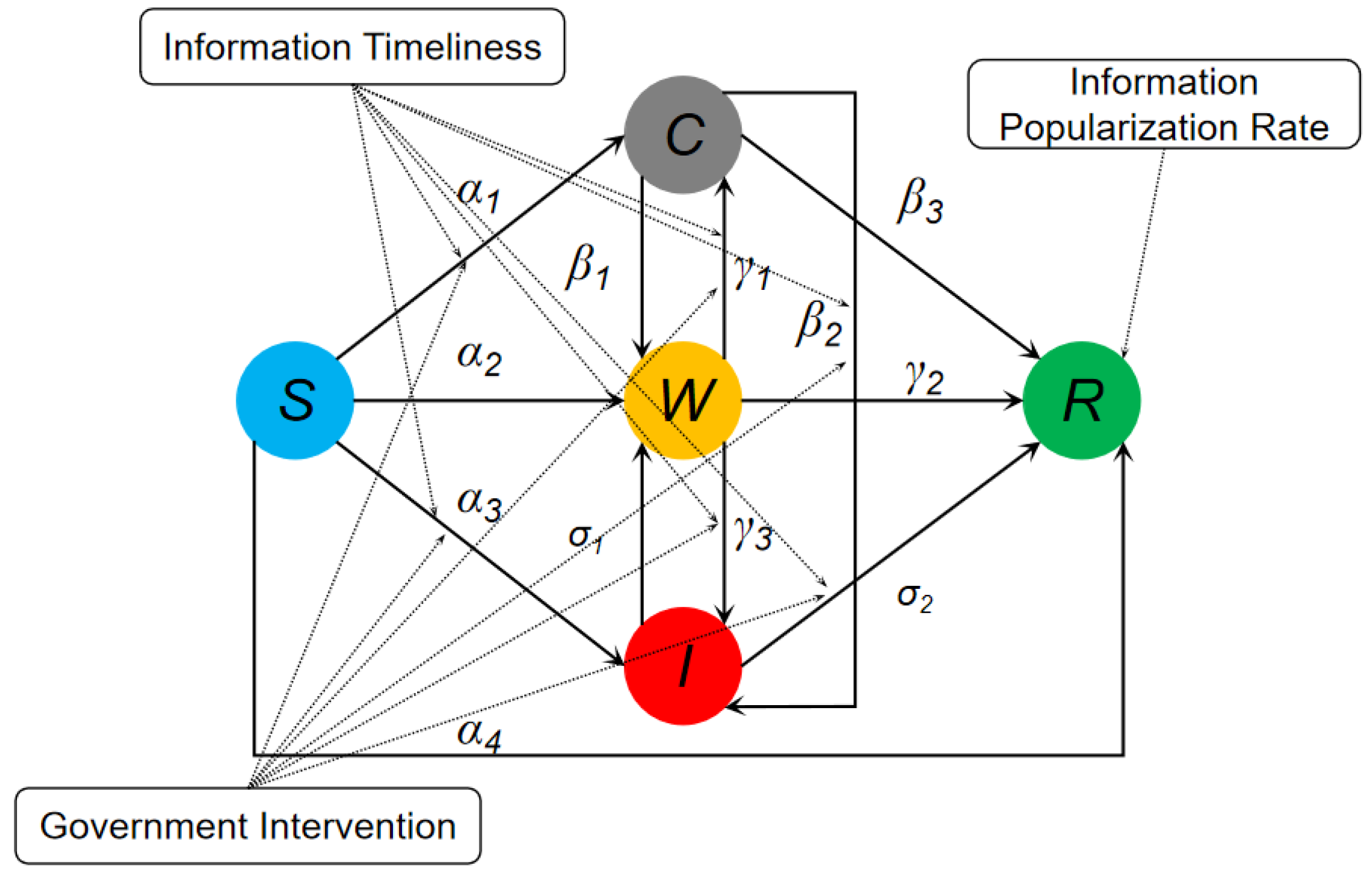
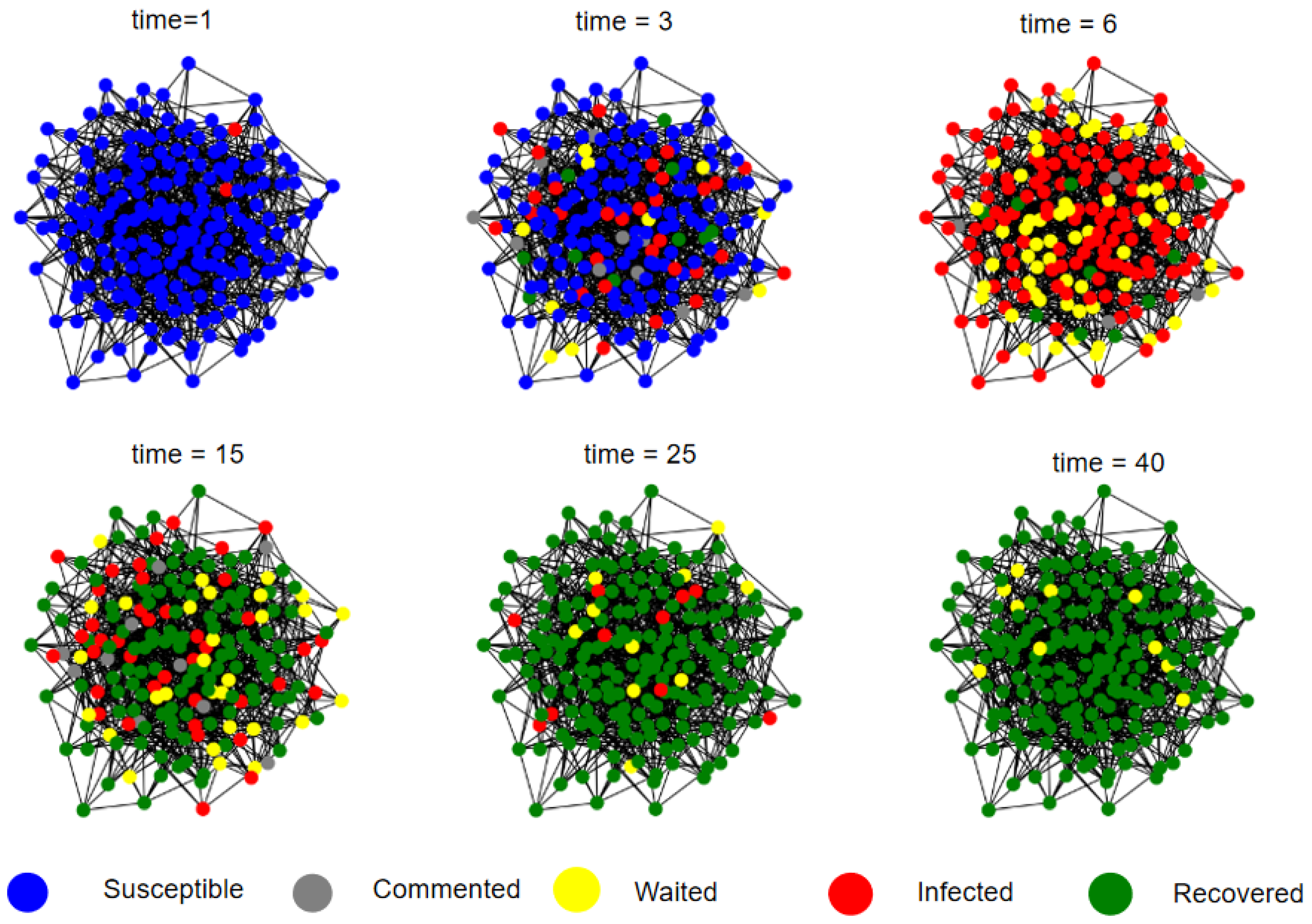


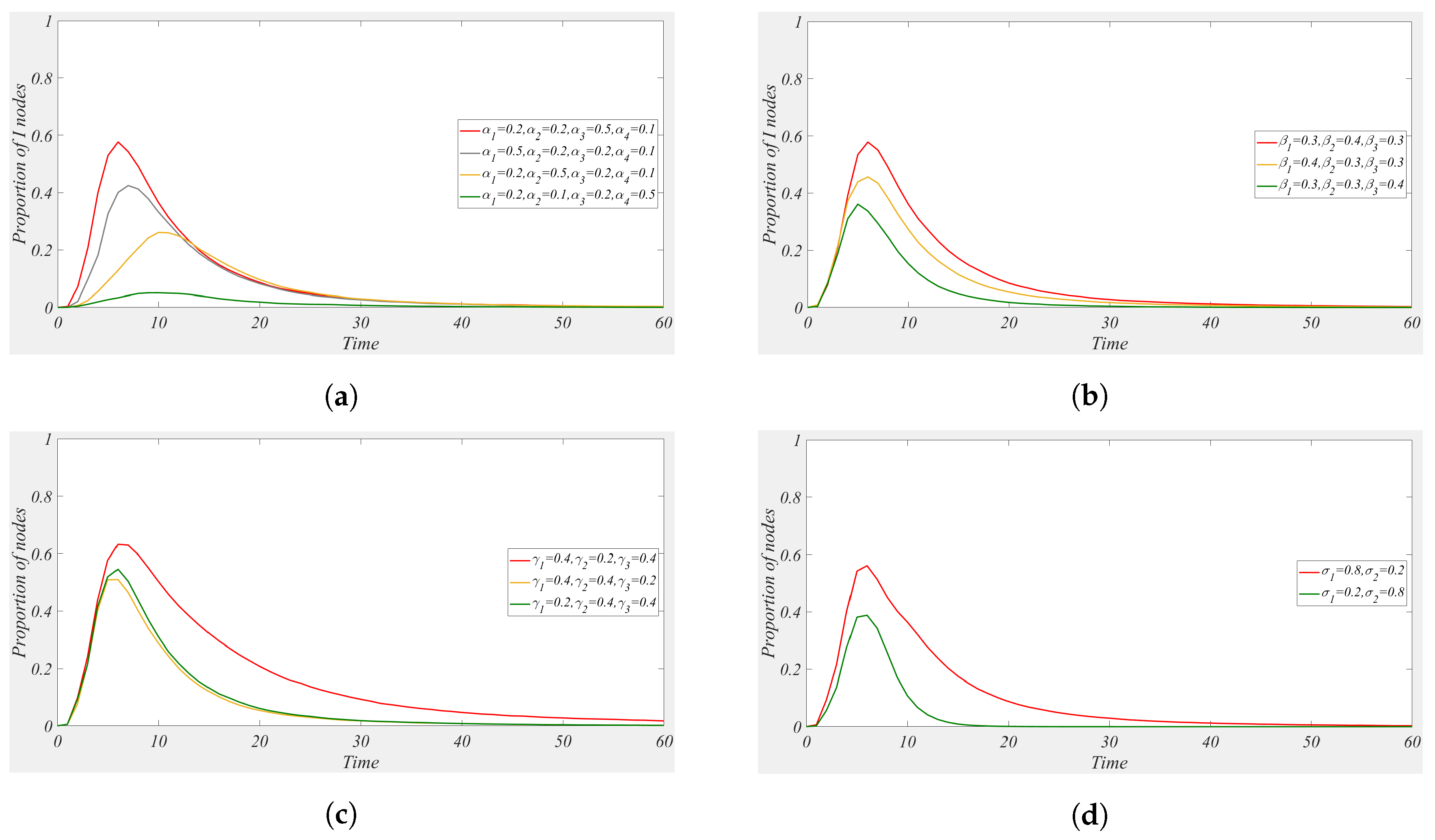
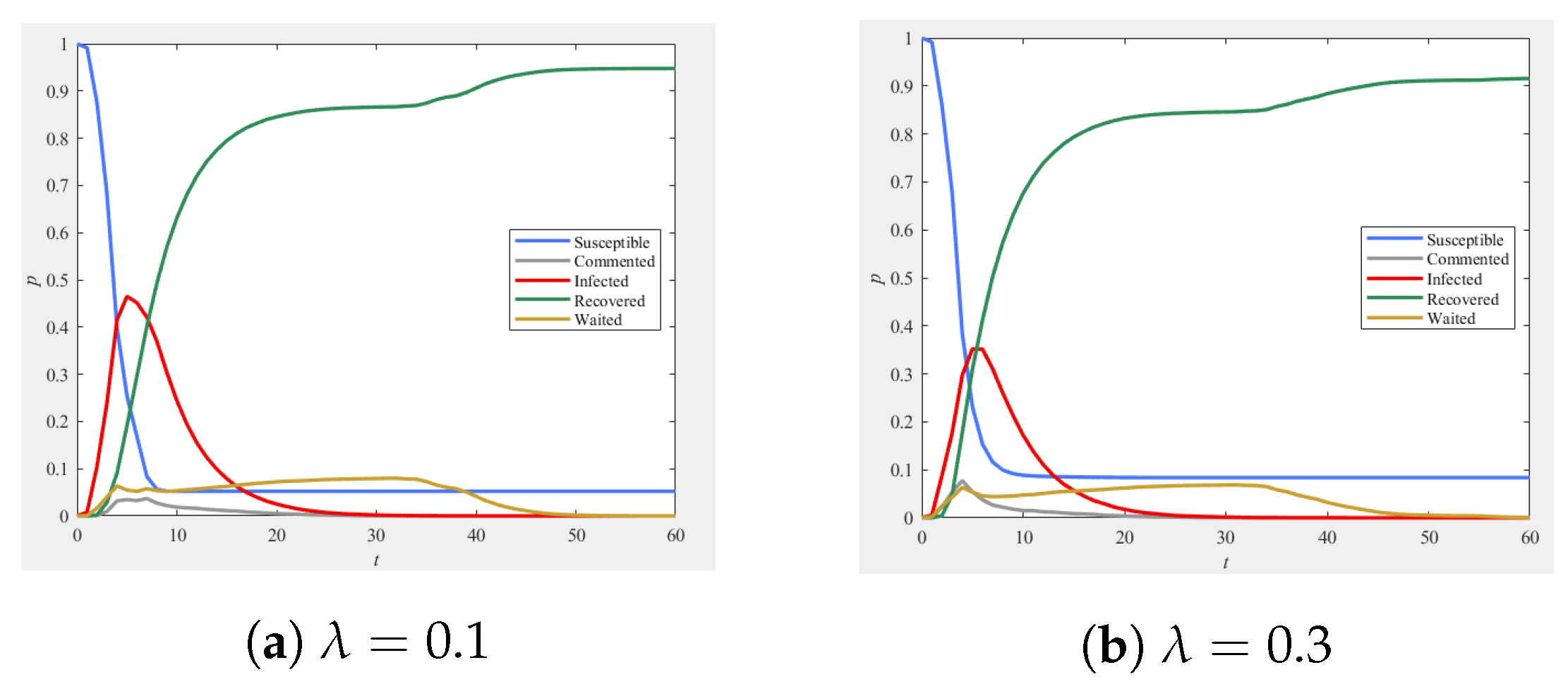



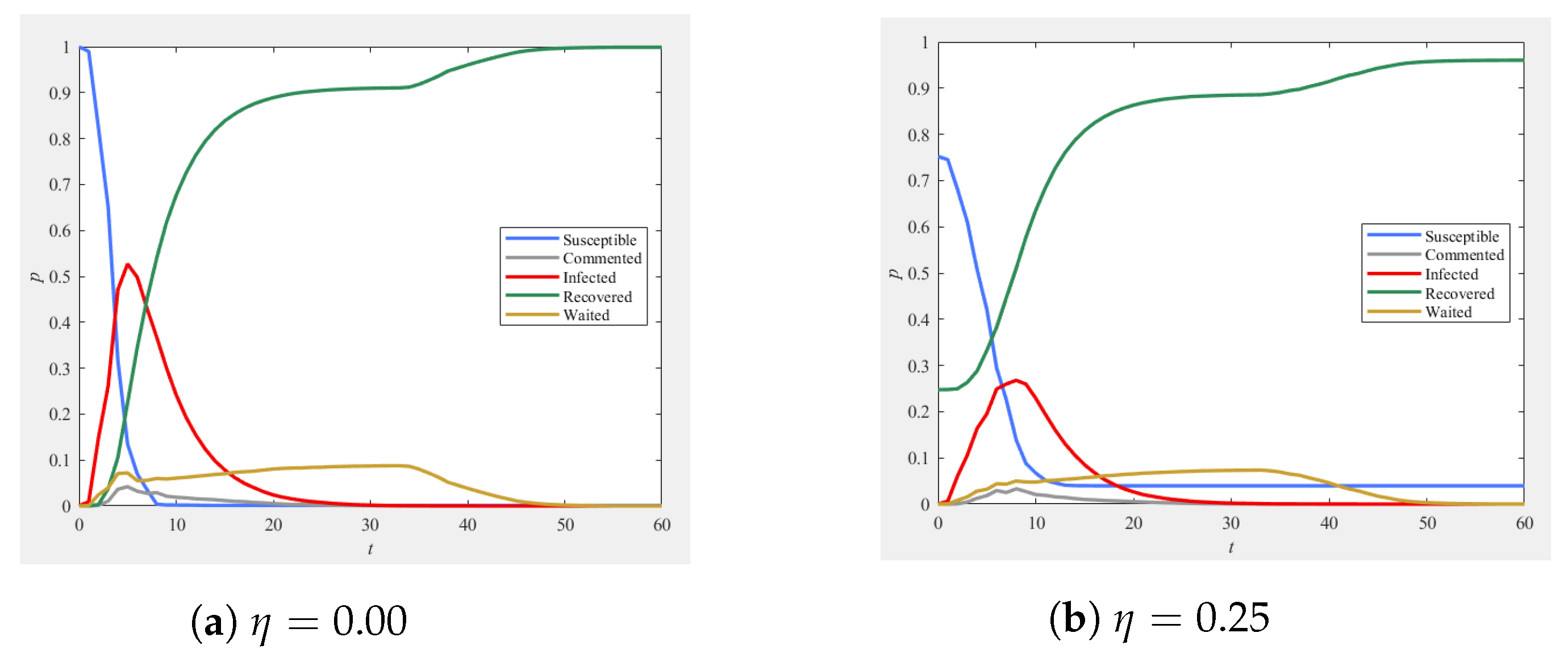
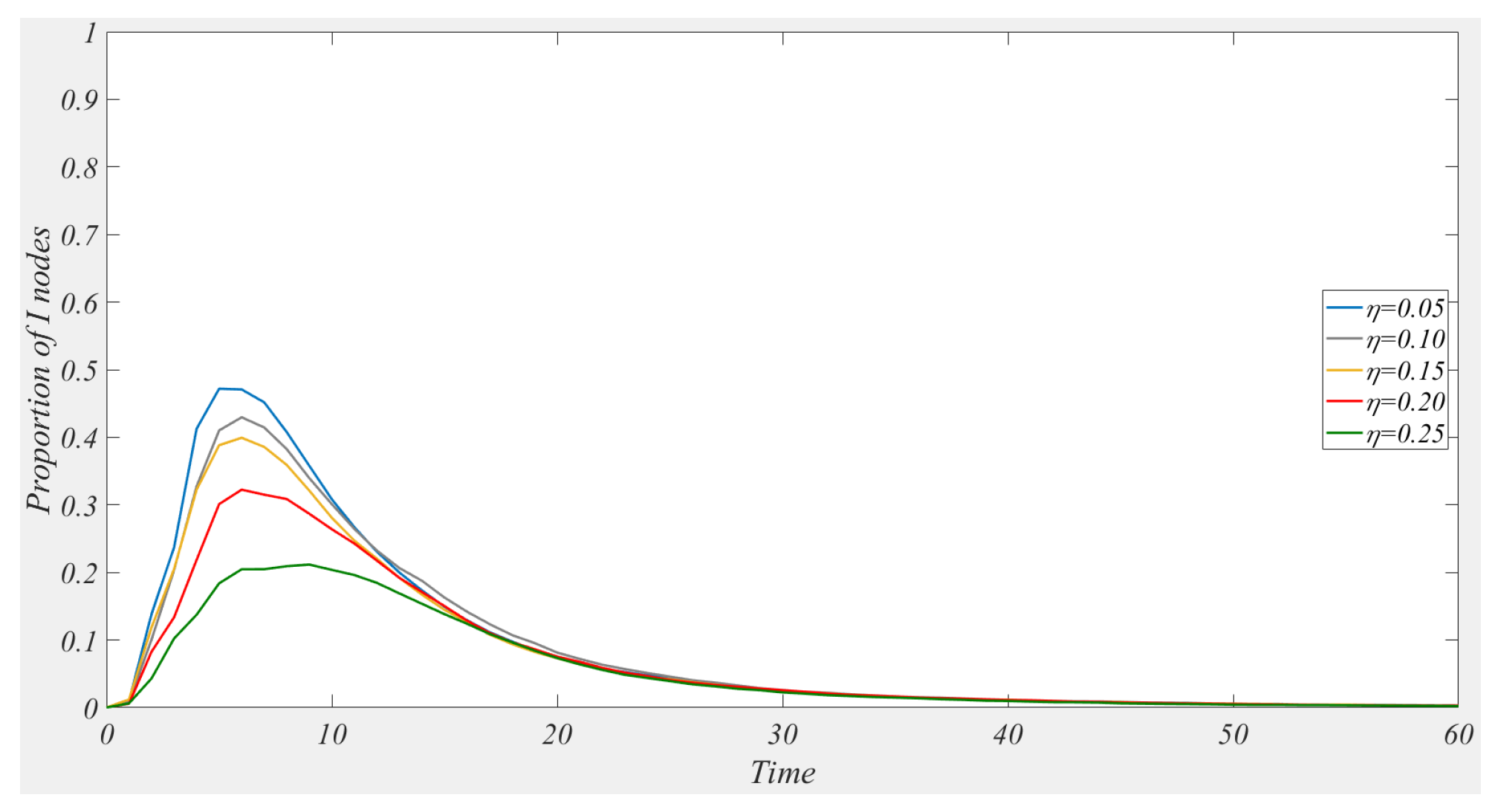

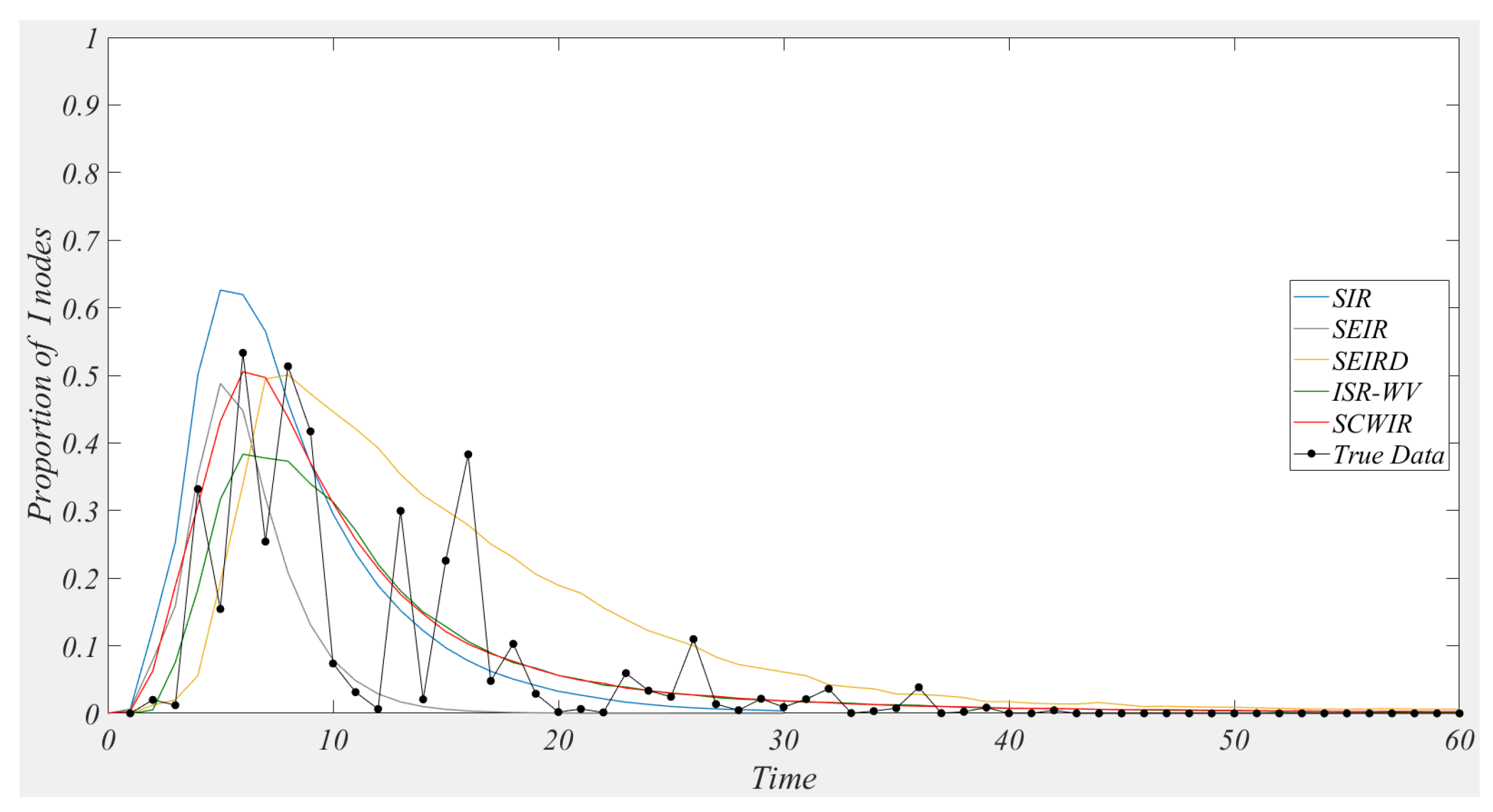
| Parameter | Definition |
|---|---|
| Probability of susceptible users engaging in comments. | |
| Probability of susceptible users adopting a wait-and-see approach. | |
| Probability of susceptibles spreading | |
| Probability of susceptibles being immune to the rumor. | |
| Probability of commenters adopting a wait-and-see approach. | |
| Probability of commenters spreading the rumor. | |
| Probability of commenters becoming immune. | |
| Probability of waiting individuals engaging in comments. | |
| Probability of waiting individuals recovering or becoming immune. | |
| Probability of waiting individuals spreading the rumor. | |
| Probability of spreaders adopting a wait-and-see approach. | |
| Probability of spreaders recovering or becoming immune. |
| Networks | NW | BA | Hypernetwork | |
|---|---|---|---|---|
| Nodes | 1000 | 1000 | 1000 | 4039 |
| Edges | 4473 | 8550 | 10,313 | 88,234 |
| Average degree | 8.9460 | 17.1000 | 20.6180 | 43.6910 |
| Clustering factor | 0.5278 | 0.5560 | 0.8252 | 0.6055 |
| Model∖Index | RMSE | Pearson Correlation Coefficient | Cosine Similarity |
|---|---|---|---|
| SIR | 0.0763 | 0.8501 | 0.8065 |
| SEIR | 0.0754 | 0.8593 | 0.8172 |
| SEIRD | 0.0744 | 0.8637 | 0.8321 |
| ISR-WV | 0.0731 | 0.8711 | 0.8695 |
| SCWIR | 0.0688 | 0.8997 | 0.8812 |
Disclaimer/Publisher’s Note: The statements, opinions and data contained in all publications are solely those of the individual author(s) and contributor(s) and not of MDPI and/or the editor(s). MDPI and/or the editor(s) disclaim responsibility for any injury to people or property resulting from any ideas, methods, instructions or products referred to in the content. |
© 2025 by the authors. Licensee MDPI, Basel, Switzerland. This article is an open access article distributed under the terms and conditions of the Creative Commons Attribution (CC BY) license (https://creativecommons.org/licenses/by/4.0/).
Share and Cite
Wu, H.; Yan, X.; Gao, S.; Deng, Z.; Chi, H. Analysis and Control of Rumor Propagation Model Considering Multiple Waiting Phases. Mathematics 2025, 13, 312. https://doi.org/10.3390/math13020312
Wu H, Yan X, Gao S, Deng Z, Chi H. Analysis and Control of Rumor Propagation Model Considering Multiple Waiting Phases. Mathematics. 2025; 13(2):312. https://doi.org/10.3390/math13020312
Chicago/Turabian StyleWu, Hai, Xin Yan, Shengxiang Gao, Zhongying Deng, and Haiyang Chi. 2025. "Analysis and Control of Rumor Propagation Model Considering Multiple Waiting Phases" Mathematics 13, no. 2: 312. https://doi.org/10.3390/math13020312
APA StyleWu, H., Yan, X., Gao, S., Deng, Z., & Chi, H. (2025). Analysis and Control of Rumor Propagation Model Considering Multiple Waiting Phases. Mathematics, 13(2), 312. https://doi.org/10.3390/math13020312





